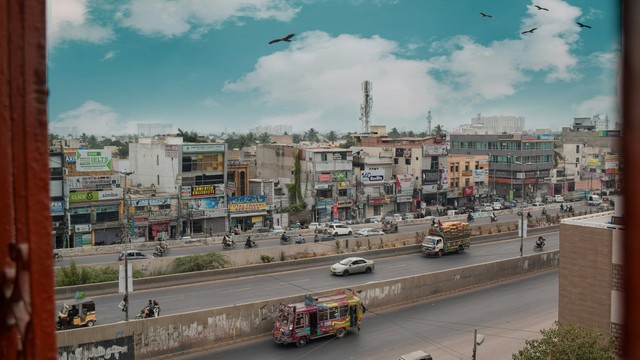Exploring inclusive urbanisation and other migration crises
In the run-up to World Cities Day, with its theme of 'living together', an IIED, IDS and UNFPA workshop will examine why the migration that helps to create cities is so often resisted, and how a more inclusive urbanisation can be achieved. Gordon McGranahan raises six key questions.


Brazil's favelas are a legacy of a more passive resistance reflecting an unwillingness to plan for anticipated population growth (Photo: Chris Jones, CC BY-NC 2.0)
When countries are urbanising rapidly, powerful voices often lament that their cities are being overrun with rural migrants – a rural-urban version of the international migrant crisis.
Evidence suggests that cities could benefit economically from opening up healthier spaces for their growing populations, but this rarely happens, in part because of the fear that planning for 'poor people' just attracts more of 'them'.
Instead, the formal acceptance of new low-cost settlements is often resisted, creating more urban exclusion, and pushing people into even worse living conditions. Can this negative cycle of resistance be transformed? How else is the 2030 Agenda, recently agreed on by governments from around the world, to be achieved?
These are key issues that will be addressed at a workshop co-hosted by IIED, the Institute of Development Studies (IDS) and the United Nations Population Fund (UNFPA) in the run-up to World Cities Day. This blog looks at six key questions that will shape the agenda.
Fine words
At an international level, at least, governments seem to agree that cities have a critical role to play in addressing poverty and inequality, and that to achieve this they need to be open and welcoming.
The 11th Sustainable Development Goal is to 'Make cities and human settlements inclusive, safe, resilient and sustainable'. Next year's big international meeting on cities and towns, Habitat III, will include a focus on the 'right to the city, and cities for all'.
Yet surveys of government views and policies on population suggest that a large and growing share of governments, particularly in urbanising regions, would prefer to have a smaller share of their population in cities and are implementing policies to reduce rural-urban migration.
In 2013, 70 per cent of governments in "less developed regions" wanted a major change in where their population resides, and 84 per cent had policies to reduce migration from rural to urban areas. In 1996, the same statistics were only 48 and 41 per cent, respectively.
Clearly cities cannot be inclusive and "for all" if the official response to urbanisation and population growth is to try to keep out those who cannot afford acceptable homes or secure acceptable jobs. But what are the alternatives? These are some of the issues the workshop will address.
Six key questions
- What is inclusive urbanisation?
Inclusion can range from avoiding discriminatory exclusion from certain areas, or from markets and services and so on, to more actively ensuring that the ways these spaces, markets and services are regulated reflect the needs of all groups, to ensuring that everyone’s human rights are met.
In the context of urbanisation, avoiding spatial exclusion is particularly critical: migrants may be excluded from the city, or forced to live in certain parts of the city and kept out of other parts, such as wealthy gated communities.
- Who suffers most from exclusive urbanisation?
Migrants whose skills are not in great demand are particularly susceptible to urban exclusion, but most disadvantaged groups can be vulnerable during periods of rapid urbanisation. Many suffer multiple exclusions.
Women living in informal settlements, for example, are often excluded from large parts of the labour market because they have primary responsibility for unpaid care work in and around the home, and the burden of that care work is amplified when their settlements are excluded from key services such as piped water and sanitation.
- How can urban politics, laws and planning be made more inclusive?
As noted in a recent IIED study, South Africa's fragmented cities are a legacy of how urbanisation was actively discouraged under apartheid, while Brazil's favelas are a legacy of a more passive resistance reflecting an unwillingness to plan for anticipated population growth. These are well known examples of a widespread tendency for politics and planning to reinforce exclusion, but it is also through politics and planning that such exclusion needs to be reversed.
Innovation in more inclusive politics and planning needs to be encouraged in cities, inclusive urban planning needs to be made financially viable, and better ways need to be found to achieve this.
- How can inclusive urbanisation be made into an economic advantage?
It is often argued that in conditions of poverty, cities must focus on getting their economies growing, and that the environment and social inclusion can be left for when they are better off. But the 2030 Agenda includes the pledge that 'no one will be left behind'.
Recent developments in urban economics suggest that there is the potential for a more inclusive urbanisation to help the economy flourish. To achieve this, it will be important to move beyond the prioritisation of the politics of economic growth on one side, and a politics of poverty that ignores the health of the economy on the other.
- How can inclusive urbanisation also benefit the environment?
If economic success is often represented as being at odds with more inclusive urbanisation, inclusion and environmental sustainability are often presented as inherently complementary. In practice, however, environmental policies often lead to urban exclusion, while some of the policies pursued in the name of the urban poor are unnecessarily destructive environmentally. Here again, better ways need to be found to overcome these conflicts, and the sharp trade-offs they create.
- How can urban inclusion help to address urban violence?
Urban violence is often blamed on rapid urbanisation and urban population growth, but the limited statistical relationship suggests it could equally be that misguided attempts to resist urbanisation are the problem, particularly when they amplify social divisions and exclusions from services, markets and spaces (as when informal settlements are refused water supplies as well as political voice).
Indeed, some of the more successful attempts to reduce urban violence have involved explicit attempts to build bridges and overcome exclusion. Such measures need to be better understood, so they too can become part of inclusive urbanisation.
We hope one of the outcomes of the meeting will be a clear statement on these and related issues, identifying priorities for action.
Gordon McGranahan (gordon.mcgranahan@iied.org) is principal researcher in IIED's Human Settlements Group and team leader on urbanisation.



